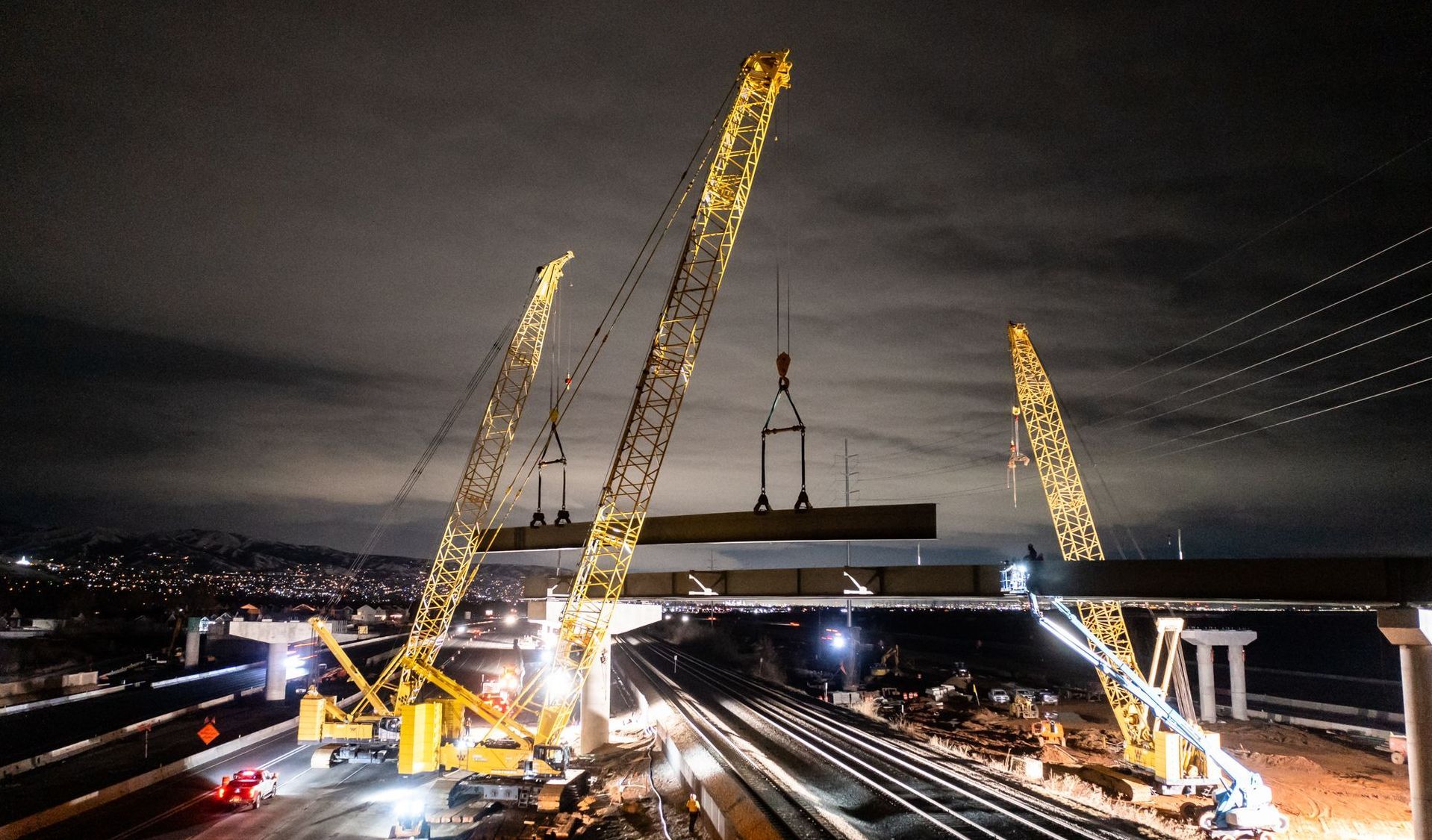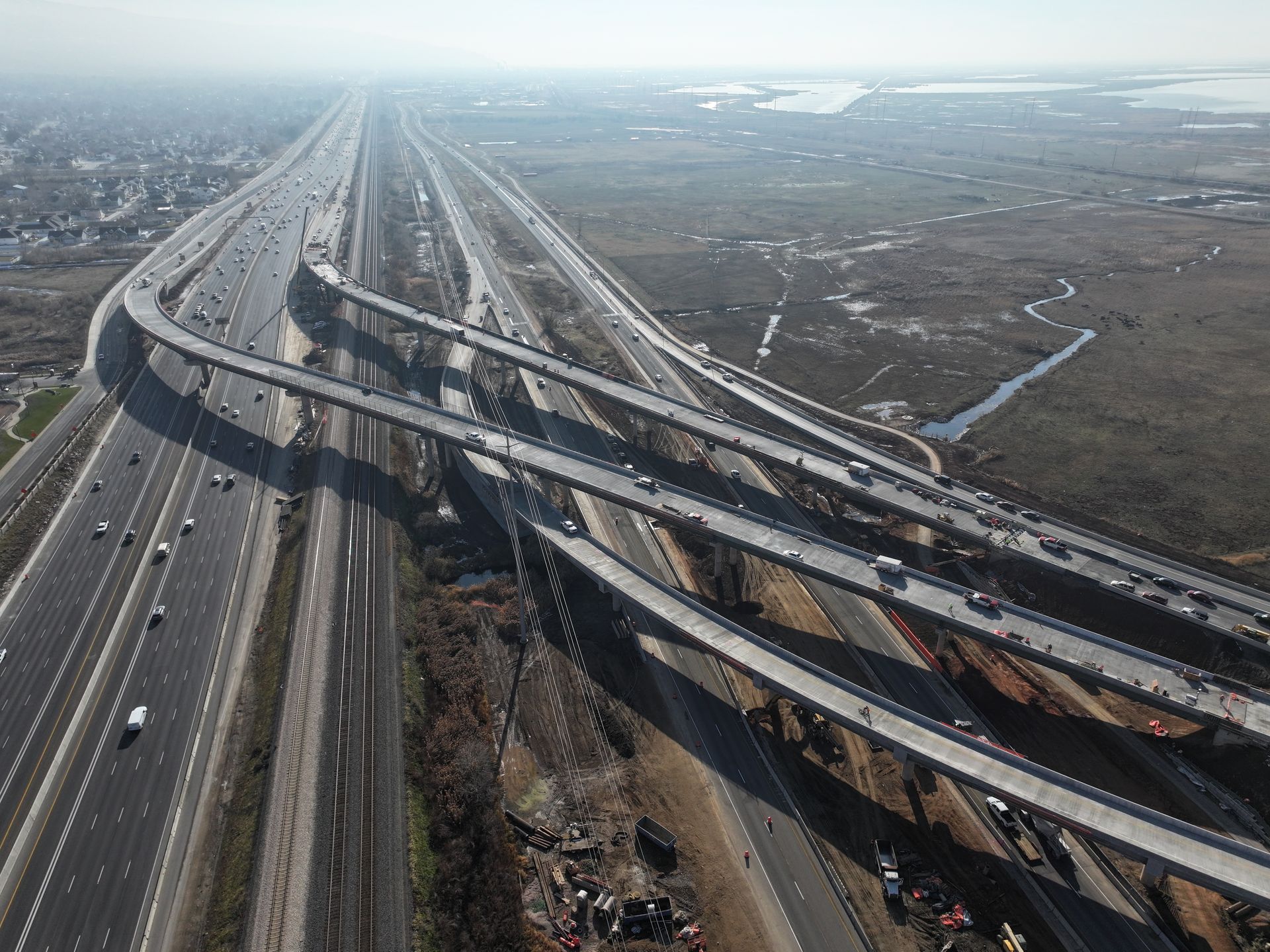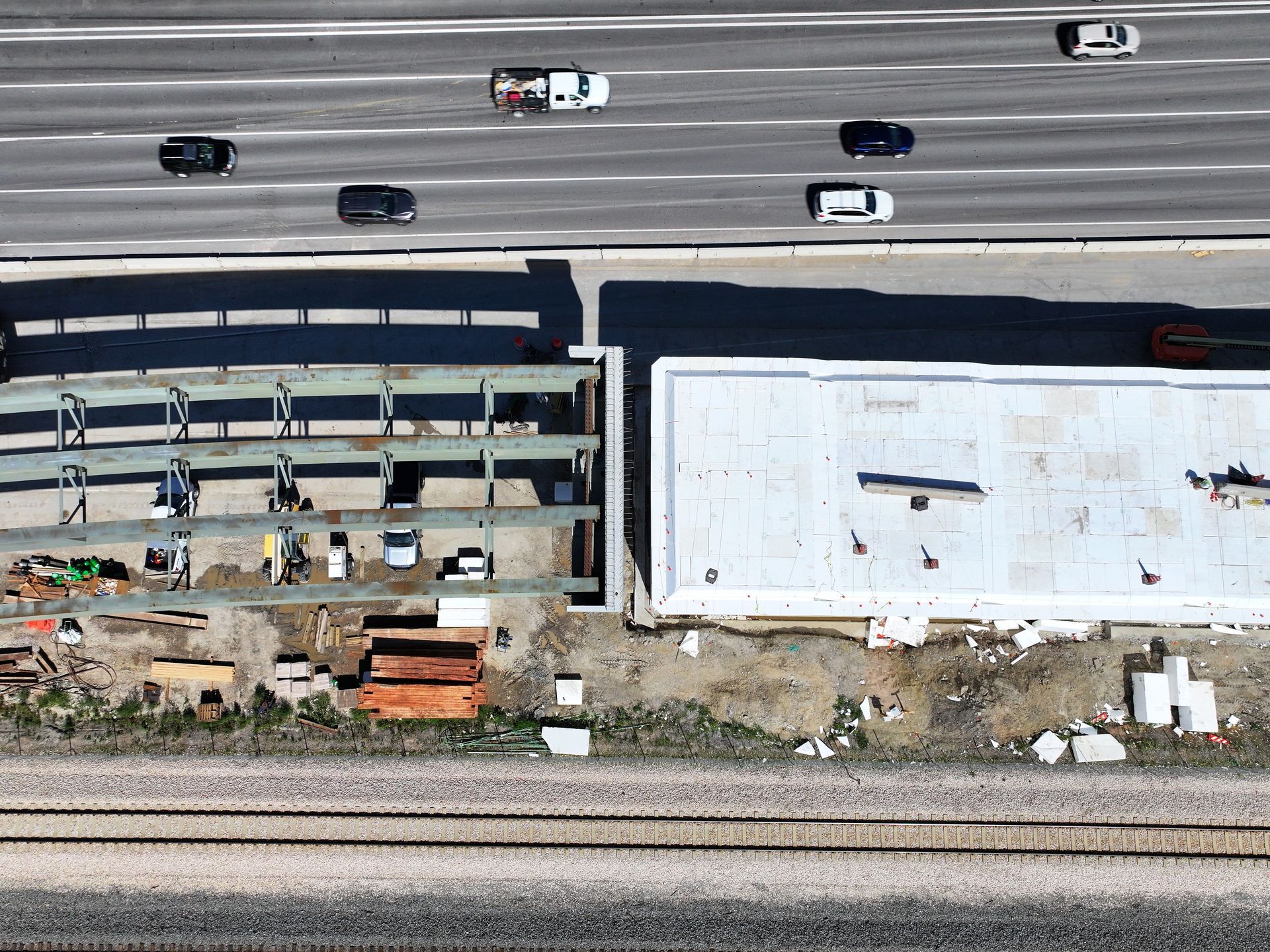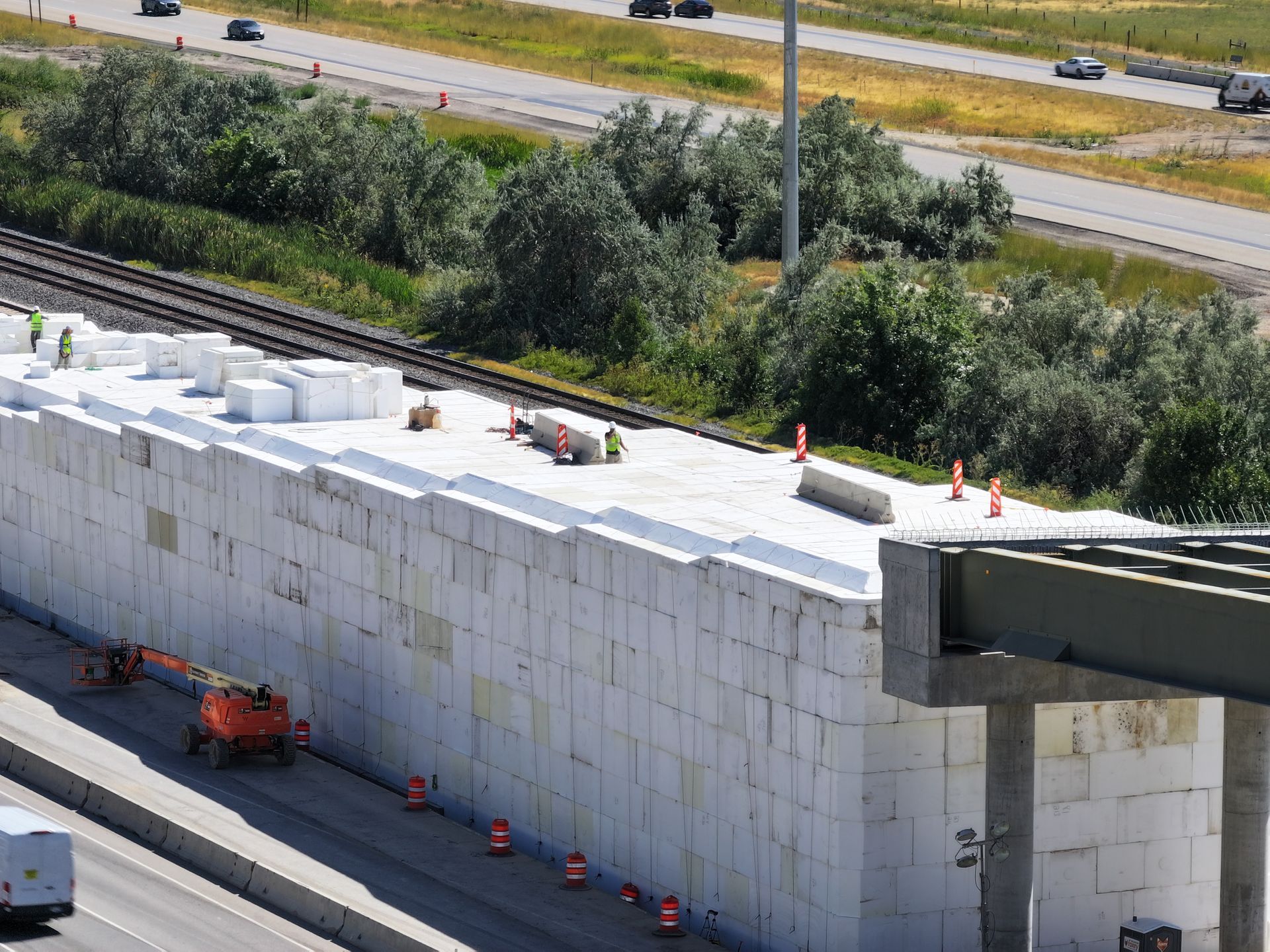The use of geofoam blocks played a key role in the overall success of the 16-mile long, $750 million West Davis Highway.
By Reuben Wright

Innovation remains a calling card for the Utah Department of Transportation (UDOT) on its major highway projects, with the recent completion of the mammoth $750 million design-build West Davis Highway (WDH) project utilizing geofoam blocks to combat challenging soil conditions and provide a solid foundation on one of the major ramps.
Comprised of expanded polystyrene, the use of EPS geofoam blocks in construction originated more than 50 years ago in Norway and was used significantly in Utah on the Interstate 15 Reconstruction from 1997-2001, which coincided with the International Geofoam Conference being held in Salt Lake City in 2001.
UDOT has implemented geofoam on various projects since then, including the 1100 South bridge over I-15 in Brigham City and the 5600 West bridge near 700 South in Salt Lake City.
"Sometimes there are unique challenges on our projects, and they require innovative solutions," said Corey Nelson, UDOT Project Manager on WDH. "Geofoam is another tool in our toolbox to efficiently build the roads, trails and bridges we all need to get where we want to go."
Nelson said approximately 3,000 geofoam blocks were used to build the ramp that connects West Davis Highway with southbound I-15 in Farmington. These blocks are considerably lighter than dirt, allowing crews to build the new ramp in close proximity to I-15 as well as the Union Pacific Railroad (UPRR) and Utah Transit Authority (UTA) tracks without concern of additional shifting or settlement.
Each block weighs about 200 pounds and measures 4 ft. by 5 ft. by 9 ft. The blocks were brought to the construction site and then either placed as-is or cut to fit as needed. Once all the blocks are in place, a concrete slab is poured on top to evenly distribute the load of the ramp pavement and traffic, and concrete walls are installed along the sides.
"The geofoam blocks helped [solve] potential issues that would have resulted from a large [tall] fill embankment being built next to a very sensitive rail corridor," said Jared Hobbs, Deputy Project Manager for Ogden-based Staker Parson Materials & Construction. "The lightweight fill helped alleviate settlement concerns and met the needs of a zero-settlement tolerance for the UPRR/UTA rail facilities."
Giant EPS geofoam blocks played a key role on the construction of this bridge ramp that connects West Davis Highway to Southbound I-15. Aerial view of the massive bridge structure, one of the true highlights of this $750 million project. (photo by Bobby Gibson; courtesy UDOT)
Three-firm JV Offers Great Depth and Unique Skillsets
Spanning six Davis County cities and constructed by the three-way joint venture of three prominent general contractors known as Farmington Bay Contractors (FBC)—Ames Construction, Wadsworth Brothers Construction, and Staker Parson—the project benefitted from having a deep pool of resources and specific expertise from each company.
Ames served as managing partner, and its self-performed work included primarily mass earthwork, retaining wall and drainage work, as well as some structural support. Wadsworth Brothers was tasked with constructing the 15 bridges and 15 box culverts on the project. Staker Parson provided earthwork, drainage, wet utility installation/relocation, aggregate base placement, and asphalt paving.
"Each partner brought unique abilities and resources to the team that complimented each other very well," said Hobbs.
Nelson added that a JV with three firms allows the team to share in the ownership, risks and returns of each project and is considered a more responsible and productive way to tackle a project the size of West Davis Highway. He praised the FBC team's ability to "work seamlessly together and deliver the project early. In this unified effort, each company shared in the overall scope of work."
West Davis Highway is a new 16-mile, 4-lane divided highway that serves primarily the west side of Davis County. The first phase of construction connects to I-15 and Legacy Parkway at approximately Glovers Lane in Farmington and extends west and north, terminating at 4500 West and the future extension of S.R. 193 in West Point. It is expected to reduce traffic delays by more than 30% on local roads west of I-15 in the county.
The project also includes over 14 miles of new trail and trail connections to create a consolidated trail system connecting Emigration Trail to Legacy Parkway Trail. The project also preserved 1,100 acres of wetlands near the Great Salt Lake to help safeguard the environment.
Former UDOT Project Director Rex Harris praised the FBC team for its cohesiveness and for its research during the pursuit of the project. Harris said FBC found out that the first four miles of the project had excessively soft soils, so the team did a test fill area that sat for 8 months before the project bid. It gave the team solid data about how the soil would behave and helped shape a forward-thinking design and construction schedule. FBC was able to lower overall risk and be more confident with its cost estimate.
"Farmington Bay Contractors [shares] UDOT's commitment to enhancing quality of life by keeping Utah moving," Harris said at the time the contract was awarded. "Their proposal provided the best value through innovation, safety, quality, and reduced impacts to local communities—at a very competitive cost."
Material Shortages, Labor and Tight Schedule Among Top Project Challenges
Like countless other construction projects around the state, supply shortages were a recurring challenge on this 30-month project. These shortages, particularly with materials like concrete, required strategic scheduling of deliveries, helped FBC to minimize schedule impact and ensure consistent material supplies.
Consistently staffing a project of this size required a sizeable workforce. Despite severe labor challenges, FBC prioritized tasks based on their importance. By strategically allocating resources and focusing on essential aspects of the project first, FBC ensured key milestones were met. FBC's strategic approach helped optimize productivity within the constraints of available resources.
The team was also able to meet the strict project schedule by successfully handling issues such as the settling of surcharge dirt, third-party utility work, a brutal winter season, and material shortages. When aspects of the schedule went beyond its control, FBC shifted focus to other tasks that could be completed in parallel and minimized the impact of delays on the overall schedule.
One of the key decisions of the entire project was determining whether to temporarily close a major arterial road in Syracuse or employ a hefty traffic management plan that would ultimately cause a longer schedule. Through extensive collaboration with the city, local emergency services, and proactive communication with stakeholders well in advance, the team garnered support for a two-month closure by emphasizing its potential to expedite the project. Remarkably, the closure progressed smoothly, with minimal complaints from the community.
Clear communication enabled residents to navigate alternative routes effectively, and the effort propelled the project significantly ahead of schedule.
Another significant challenge was moving and hoisting precast concrete and steel beams exceeding 200 ft. in length. Careful coordination was required for their placement between dozens of organizations—from orchestrating travel arrangements for the beams to scheduling road closures, the process was complex and intense. Detailed erection plans, some spanning 200+ pages, showed the intricacy of the undertaking. Critical areas such as I-15 in Farmington and Antelope Drive in Syracuse necessitated extensive planning. Transporting and erecting the beams required Utah Highway Patrol escorts and specialized semi-trucks, with only two trucks available statewide.
According to Dustin Belnap, Project Superintendent for WBC, the giant I-15 structure is an eight-span bridge with approximately 1.25 miles of total girder length, clocking in at a mind-boggling four million pounds. It spans over I-15 in both directions, over the UTA and UPRR tracks, under high-voltage power lines, and over both directions of Legacy Highway, allowing northbound I-15 traffic to access the West Davis Corridor.
The erection process took months of planning between Farmington Bay Constructors, UDOT, UPRR and Rocky Mountain Power all working together in a highly collaborative process. The duration of erecting the steel took approximately four months to complete using nighttime lane closures and weekends, to ensure that traffic, as well as trains, kept moving as much as possible during the process.
Asphalt paving crews performed admirably, given that they placed over 433,000 tons of material, a special performance-grade asphalt that includes additional polymers for added durability. The highway also had a 1.5-in. layer of SMA (stone matrix asphalt) placed on top. Crews also placed more than 71,000 cu. ft. of curb and gutter, 162,000 LF of pipe, 267 bridge supports, 246,000 LF of fence, 281 new lights, and over 1,100 new signs.
Hobbs said one unique aspect of the paving process was that the pavement section had a lot of variance in the final design, with it based on projected traffic counts of future roadway use. For example, at different longitudinal sections where anticipated traffic counts are less than other sections, that section was thinned (or thickened) to handle the future demand. Another example is ramps and outside shoulders having different pavement sections than the two mainline general-purpose lanes. In all, crews placed 330,000 tons of granular borrow (subbase), 850,000 tons of untreated base course, and 430,000 tons of asphalt mix material.
In future phasing, the highway will extend to 1800 North in West Point, with long range plans for it to possibly extend further into West Haven and Hooper, ultimately connecting back to I-15.
Grade-separated interchanges were constructed at Legacy/I-15 (Farmington), 950 North (Farmington), 200 North (Kaysville), 2700 West (Layton), 2000 West (Syracuse), and Antelope Drive (Syracuse).
"It goes without saying that any successful project can be attributed to a team of individuals working together towards common goals," Hobbs concluded, offering praise to all firms who contributed to this mighty effort, including UDOT Region 1, Salt Lake-based HDR and Pleasant Grove-based Horrocks Engineers (program management), Midvale-based Raba Kistner (QA/QC), many key subcontractors and other third-party representatives.

West Davis Highway
Location: Davis County (Centerville, Farmington, Kaysville, Layton, Syracuse, West Point)
Cost: $750 Million
Start/Completion: May 2021/January 2024
Delivery Method: Design-Build
Length: 16 miles
Surface: Asphalt
No. of Bridges: 15
Project Team
Owner: Utah Department of Transportation
Owner's Rep: Corey Nelson (PM)
Design Team
Program Management Team: HDR; Horrocks Engineers
Design: HNTB; FBC
Construction Team
General Contractor: Farmington Bay Contactors (FBC)—JV of Ames Construction; Wadsworth Brothers Construction; Staker Parson Materials & Construction
Earthwork: FBC (Ames; Staker Parson)
Retaining Walls: FBC (Ames)
Bridges/Box Culverts: FBC (Wadsworth Brothers)
Paving: FBC (Staker Parson)
Steel/Rebar: Utah Pacific; Harris Rebar
Subcontractors/Role: Cache Valley Electric (ATMS/Electrical/Signal; Gateway (Painting); Restruction Corp (Polymer); Craghead (Curb Gutter/Sidewalk; Harper Precast (Noise Walls); Comers (Concrete Barrier and Coping); RECO (MSE Walls Fabrication); CellCrete
































